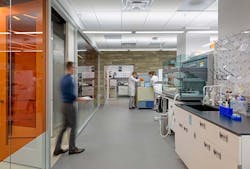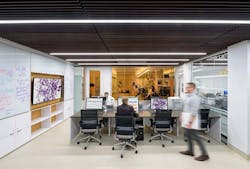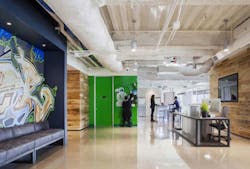How to design transformative scientific spaces? Put people first
When you think of a research lab, you might conjure images of sterile equipment and white lab coats—and there is some truth to that picture. Designing research labs requires meticulous attention to the details of equipment planning, environmental health and safety (EH&S) and the processes that support science. While most labs are designed to achieve that basic functionality, a transformational lab environment prioritizes a science organization’s most valuable assets: its people.
Inspired by the user experience design approach pioneered by tech companies, our design process now considers how scientists initially interact with, and continue to stay engaged with, their environments. Three elements of this user-centric process drive a deeper understanding of the functional necessities to improve the work experience and seed innovation.
Establish a common language
Across the broad array of clients that we work with, the convergence of scientists of different areas of expertise is a common thread. For example, many companies known for chemistry are now using biotech industry techniques to develop their own processes and products. Scientists from different fields have developed distinct dialects, and while there can be similarities among them, the diversity of these dialects creates barriers.
By structuring initial user conversations to encourage engagement, we establish a common language, finding otherwise missed opportunities for optimization. With this strategy, we uncover and break down complex issues and link information, so that the different parties can collaborate and develop shared processes. We find this type of engagement especially useful when working across organizational teams of scientists, engineers, human resources and EH&S professionals.
Find the roadblocks, free the scientists
Due to the specialized nature of their work, scientific users have a hard time defining their needs. In fact, they typically have internal biases or misconceptions that can lead to incomplete or skewed information. For this reason, during the design process we ask that they translate their knowledge and process into user requirements.
Because of project speed and complexity, a lot of initial user requirements are taken from the last time a similar project was developed, which could have been as long as a decade ago. Even if these requirements are updated, they are still based on assumptions and historic precedence at odds with current best practices. Carefully facilitated dialogue with the end users is a highly effective way to establish the needs and requirements that will take the experts and their environments forward.
By nature, scientists will hack their space once they occupy it. By integrating the perspectives of scientists, EH&S, suppliers and facilities engineers early in the process, you move this step to be a part of the design process. Facilitated user discussions uncover operational efficiencies and affinities between programs that would have never been found via a user requirements brief. Having the opportunity to discover obstacles in the daily work of science, both in and outside of the lab, gives leadership the opportunity to set new procedures that will release the scientists to focus on their key mission of developing new therapies and technologies.
Plan for change
To create a truly efficient and effective laboratory environment, refinement to operations and organizational models needs to align with the new physical environment. Change management becomes critical to helping research organizations realize the gains in operational efficiency and enhanced workplace culture that comes with new facilities. Most clients’ goals include aspects of organizational and process improvement, but they generally don’t dedicate the necessary resources. To accelerate change, we have found that integrating an inclusive change management strategy with the design process is the most effective way to implement innovative and new processes into the scientific work environment.
Because the scale of organization that we often work with is too large for the entire organization to be involved, we have successfully worked with companies to develop a network of Change Champions who own and influence the adoption and integration of new processes. These embedded influencers know the day-to-day needs of their groups and can inform the design from the inside out. They also act as conduits to their colleagues providing information and collecting feedback on changes being developed for their new environment.
By engaging innovators and early adopters as Change Champions, you can disrupt archaic ways of working and push the boundaries of scientific process. These early adopters will communicate and interact with their peers, building consensus and support of new thinking that will ultimately create a transformational laboratory.
Designing the transformational lab space
User engagement has become a fundamental part of our design process as it uncovers specific needs that wouldn’t have otherwise been found. It establishes the base and pillars required to develop truly transformational research facilities. This is achieved by simplifying and distilling complex information, developing a universal language, challenging conventional thinking and managing change to ultimately develop great science. This approach unlocks opportunities and operational efficiencies beyond the brief, to design environments that enable transformative science.
About the Author
Gensler
A global design firm with more than 5,000 practitioners networked across five continents, Gensler features insights and opinions of architects and designers on how design innovation makes cities more livable, work smarter, and leisure more engaging. Our contributors write about projects of every scale, from refreshing a retailer’s brand to planning a new urban district, all the while explaining how great design can optimize business performance and human potential. For more thought leadership and blog content, visit our Research & Insight page. Follow us on Facebook, LinkedIn, and Twitter.


